Tourism | Industry | Fishing | Market Gardening | Golf
[In the late 1940s/early 1950s] most worked in the mills but also in fishing; there was Brunton’s wire manufacturers, who had been making wire for musical instruments and ropes since 1878, latterly providing the cables for the Forth Road Bridge. There were also the net mill, the cotton mill and the paper mill in which my father worked, when it, as well as the wire mill, worked continuously in three shifts over 24 hours.
A neighbour was a baker in one of the five bakehouses/shops and was up very early to start work at 4.30am. He came home for breakfast about 8.30am and was back in the forenoon too.
Others worked in Edinburgh and travelled by train from Musselburgh station, or by bus or tram. There was an excellent train service to Edinburgh, which I used as I worked in the Royal Scottish Academy office, organising exhibitions, etc. I got the 9.15am, as I didn’t start work until 10am, but had a mile to walk from home to the station.
Margaret Urwin
Tourism
Visitors are drawn to the town by a number of attractions, including the birdlife on the lagoons (see Environment), the racecourse, the golf courses and the shows put on at the Brunton Theatre.
Musselburgh Racecourse has been in use since 1816; there are 20+ race days per annum and, since 1987, both Flat and National Hunt racing are offered over the mile and a quarter track. The provision and equipping of the National Hunt facility cost around £80,000, when a new hospitality suite was built and the stable yard upgraded.
Of all the events at the racecourse, it is perhaps the pacing and trotting events of the Fair Day Races that ‘belong’ to Musselburgh people; traditionally these are held on a Tuesday evening (The Hurricane Pacing Handicap) and the Wednesday afternoon following (The Famous Musselburgh Pace), during the first fortnight in August. From its start in 1893, the Fair Day Races have run almost every year since, with only a few years when no event took place. The local flavour of the events disappeared (possibly before 1945) and the races attracted competitors from near and far. The races have been an annual event throughout 1947-2000, organised under the auspices of the Musselburgh Fair Day Association. Some of the sponsors are Musselburgh families (for example the Finlaysons and Robert Gibson’s family) who remember loved ones by sponsoring a race. The Holmes family continues its role in the association with family members (Kemps and Flemings) as directors of the association.
The races attract both local support and bring a large number of spectators to the town. The centenary celebrations in 1993 were particularly well supported.
The only purpose-built theatre in the county is the Brunton Theatre, Musselburgh. Mr John D. Brunton, son of the founder of the Brunton Wireworks, died in 1951 leaving a bequest of £700,000 to the town of Musselburgh and he was specific that the money be used to provide halls and other municipal buildings. Musselburgh Town Council decided to add money of their own so that they could group their administrative offices within the building.
The Brunton Hall was opened by Queen Elizabeth the Queen Mother in 1971. Designed by Rowand Anderson, Kininmonth & Paul, the building is an example of late 1960s civic architecture, with a large concrete structure housing halls, offices and a courthouse.
Several enthusiastic amateur drama and operatic societies performed in Musselburgh at this time and so, at an early stage, it was decided that the Brunton Hall complex should include a proper theatre, fully equipped and seating up to 360 in steeply tiered seats.
In 1979 the theatre established its repertory company, the Brunton Theatre Company, with artistic director Sandy Neilson. In 1994 the Brunton Theatre Trust was founded. The trust was successful in its applications for funding in 1995 and received £328,000 from the European Development Fund, £1.2 million from Scottish Arts Council National Lottery Fund and £400,000 from East Lothian Council. Work on the refurbishment of the Brunton Theatre commenced in spring 1996. The main contractor was Barry D. Trentham Ltd.; mechanical and structural engineers, Harley Haddow Partnership; and the interior designers Weddell & Thomson. The theatre reopened in spring 1997.
The theatre refurbishment included a new fly tower and restaurant and the installation of facilities to make access easy for those with disabilities – both performers and audience members. They were developed in consultation with Disability Scotland and include audio description booth, tactile signage, loop and infrared systems, passenger lift and wheelchair gallery. The theatre can now seat 300 patrons, with six seated in the viewing gallery.
The colour scheme uses the ‘B’ colour logo with a complementary blue and a contrasting red. The glass in the restaurant and bar was the result of a competition run by the trust, which invited glass artists to submit ideas for those areas. The winner was Glasgow-based artist Deborah Campbell, whose design is based on the Musselburgh Fishermen’s’ Walk with fish, creels, seaweed and waves forming the background to the design. The seating, carpets, furniture and light fittings were purchased through the interior designer and are from firms throughout Britain. The carpet is from a firm in England. The marble counters are real marble. The panelling throughout the foyer and bar is made from sprayed MDF. The table- tops are laminate. The flooring in the restaurant is Amtico. The brass trim is lacquered brass.
The restaurant is franchised and serves coffees, snacks and lunches and is open throughout the day, Monday-Saturday, normally closing at 5pm except when there is a theatre performance, when suppers are served.
Industry
Crudens | Bruntons | Paper Mill | Net Mill | Mining
The burgh was long home to a number of labour-intensive industries (see below). By 2000 many of these had gone and industry in the burgh was represented by smaller mostly modern industries, many of which were located in the new industrial estates around the town; these sites included Esk Mills Park; Fisherrow Industrial Estate on Newhailes Road; Inveresk Industrial Estate (opened 1983); Inveresk Mills Industrial Park; and Newhailes Industrial Estate, Newhailes Road.
A number of local industries did continue to thrive:
The Cruden Group, building and civil engineers, commenced trading at Olivebank in 1943 as Murray & Cruden Ltd. The parent company, Cruden Investments Ltd. purchased Hart Builders of Macmerry in 1973 and the principal trading operations are now Hart Builders (Edinburgh) Ltd, Cruden Building & Renewals Ltd, and Cruden Estates Ltd, both based in Glasgow, and also Cruden Homes (Scotland) Ltd and Cruden Property Developments Ltd, both based at Baberton, Edinburgh, along with Cruden Investments Ltd.
In 2001 the group has a turnover of £79million and had an average of 715 employees. The group is largely owned by Cruden Foundation Ltd, a charity set up by Mr & Mrs Cruden in 1956. In the last 30 years, Cruden Foundation has given approaching £2million, mainly to Scottish charities.
M.J. Rowley, Managing Director Cruden Investments Ltd.
By 1960 Crudens was the largest company of building contractors in Scotland; the firm was responsible for many of the building projects in the locality, not least of which were the 85 houses at Newhailes. Four apartment, two-storey terraced houses were priced at £3,150 and a garage cost an additional £250.
… This was Crudens’ first big venture into … private house building. … Housewives will be glad to note that there is plenty of pram or cupboard space underneath the staircase. Often a lot of time is wasted by the housewife as she trots from the kitchen to the living room …but a timesaver … in the shape of a sliding hatch between … kitchen and dining room. Here again Crudens have realised that the housewife can never have too many cubby holes… lavish cupboard space in the kitchen.
(Musselburgh News 1961 December 8)
In 1967 Crudens was awarded a £4.75million contract in Dundee.
Pirelli Construction, Millhill was awarded the £9million contract in 1987 for the electrification of the east coast railway line between Edinburgh and Berwick on Tweed, securing 100 new jobs over the next two years.
In 1968 the precision engineering firm McKettrick-Agnew & Co Ltd moved to a newly built factory on the Macmerry Industrial Estate (opened 1960): the firm had begun at Brewery Park, moving to Olivebank some years before. It employed 30-40 engineers.
For 40 years Hall Brothers motor agents ran their garage on Harbour Road, but went into voluntary receivership in September 1984.
The makers of fairground equipment, George Maxwell & Son, survived until October 1982, when the firm went into liquidation following a decline in the market. The firm was established in 1849. It started up again as the Musselburgh Wagon Company.
In 1945, there was but a single brewery remaining in town – John H. Young & Co. Ltd., producer of Fisherrow Ales and the famous ‘Wee Heavy‘. In 1968, it was acquired by Whitbread’s Brewery. It was still in business in 2000, but closed shortly after.
Other industries thrived at different times. These included Heather Valley Knitwear and Henderson’s Fat Factory, makers of ‘Lothian Potato Crisps’ both on the High Street in the 1960s. The presence of two manufacturers of lemonade in the town was an indication of the drink’s popularity: Telfer’s lemonade factory was on New Street during the 1950s-early 1960s and Leith’s – selling their Gold Medal lemonade on the High Street – was bought out by Barr’s in the 1970s.
S. Luca of Musselburgh, dairy ice cream makers since 1908, still have their factory and very popular shop in the High Street near Pinkie Pillars. They also have a retail outlet at Morningside in Edinburgh (opened 1999).
The other well-known ice-cream maker in Musselburgh is Di Rollo. They were established in 1899 and their shop is in Bridge Street opposite the Brunton Hall. The factory is located nearby in South Street.
The Big Three
On a 22-acre site south of the Mall, Brunton’s wireworks was once the largest employer of labour in the town (1000+ in 1960), but over the period Brunton’s saw both expansion and decline. From the 1950s it seems that bridges across the world were suspended from Brunton’s wire cables – the Forth Road Bridge being the best-known local example. In 1975 the net profit was up by 3.7% in the seventh year in a row and in 1976 Brunton’s celebrated its centenary (Musselburgh News 1976 December 17). At this time the factory comprised eight interdependent units.
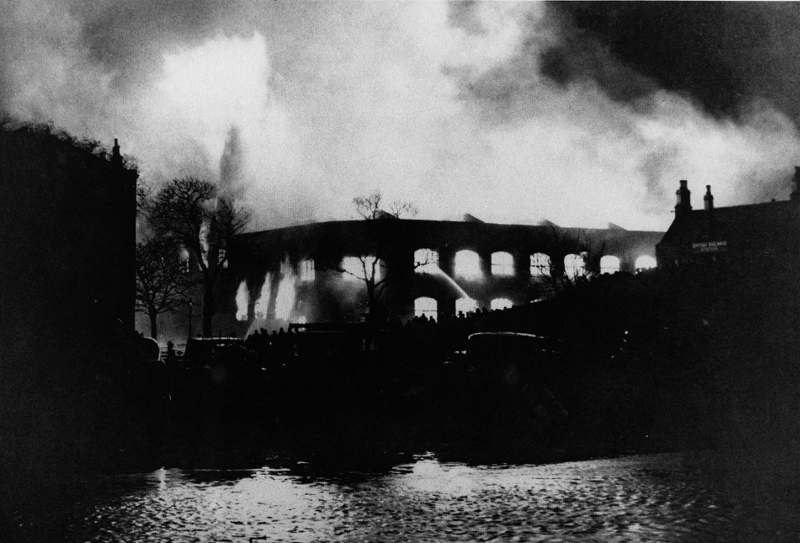
Brunton’s Wire Works on fire, March 1950

Brunton’s Wire Mills after the fire 3 March 1950
Across Britain the 1980s brought recession, the result of a combination of economic problems and competition from abroad. From July 1980 some 170 employees were on short-time and the following year 100 redundancies followed. By May 1986, 300 were made redundant and that July Brunton’s was the subject of a £5million takeover by Carclo. In 1988 Carclo PLC acquired Brunton’s (Musselburgh) Ltd.; there were a further 69 redundancies. In October 1991 it was announced that four of the firm’s departments were to close and a quarter of the remaining workforce faced redundancy. Two years later a further 88 lost their jobs and all wire drawing facilities closed. In 1995 the workforce was reduced to 80. In February 1997 Brunton’s closed, ending 121 years of wire manufacture in the town.
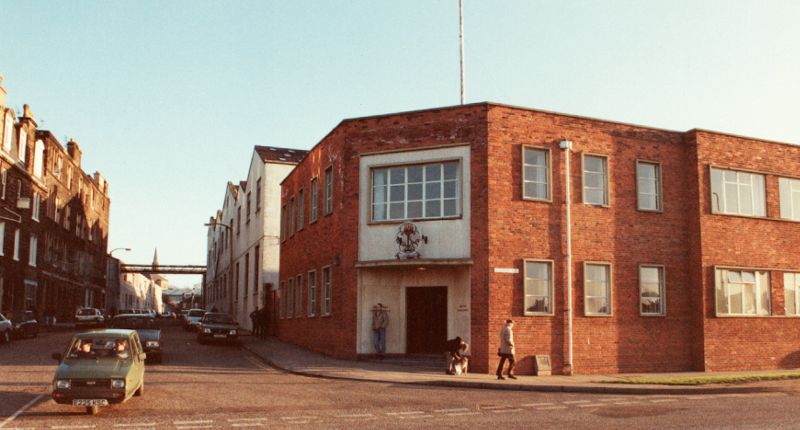
Brunton’s Wire Mills on corner of Station Road and Inveresk Road February 1990
The story of the linked Gilby Brunton company is similar. Formed in 1936 by John Brunton and others at Seafield, in 1972 it became a wholly owned subsidiary of Brunton’s, specialising in the production of 47 different wire alloys. In 1984 Gilby Brunton moved to the Inveresk site; it closed in 1992.
A small glimmer of continuity emerged from Brunton’s remains; the Aero department survived. In 1991 Aero won orders to supply control cables for Jetstream 41 followed in 1994 with a contract to supply Airbus. When in 1995 Brunton’s (Musselburgh) Ltd. merged with John Shaw Ltd. (another Carclo group company) the Aero Department was not included in the merger. A new company was formed – Brunton’s Aero Products Ltd. – which relocated to the rope factory. The strip department was sold to David Fabb Holdings. Brunton’s Aero Products Ltd. moved into new premises on the Inveresk Industrial Estate in 2000. Currently their web site describes Brunton’s Aero Products as
Manufacturers of aircraft mechanical control cables, specialised machine parts, aerofoil blading, streamline wires and tie rods.
Donald Manson, who worked at Brunton’s for 51 years, shares some of his memories of his time there:
I began my apprenticeship as a toolmaker in Brunton’s wire mills on 31 January 1934; time served by 1939; joined the Territorial Army, served with the BEF in France; evacuated in 1940 and returned to factory life, my trade being a reserved occupation. Long hours at work and Home Guard duties were the main occupation of the years until the end of the war.
The department I was employed in and where I eventually became manager specialised in manufacturing cadmium coated and stainless steel aircraft wires, control cables and aircraft fittings. For a short period the company went into the manufacture of commercial work, small components for IBM Veeder-Root and Smith’s Clocks, but after a short period we returned to our bread-and-butter work.
In the 1960s turbine blading for aircraft engines was introduced along with stainless steel rigging for yachts; many of the America Cup boats were rigged from Brunton’s. After the war the government introduced officers from the army, navy and air force to train as managers on the factory floor but this was short-lived and the firm reverted to the old and tried method of promoting managers from the shop floor.
The 1950s and 1960s saw the introduction of time and motion study, which in its various ways stood the test of time. Brunton’s Musselburgh Limited was a collection of factories under one roof, or under several roofs as the factory expanded over the years. The largest part was, of course, the Wire & Wire Rope Department, making colliery winding ropes and bridge ropes for the Forth Road Bridge and the Bosphorus Bridge and dozens of bridges throughout the world.
The Mall Park Strip Department rolled flat coiled strip, producing thousands of tons per year for companies such as Hoover and Veeder-Root.
The Shapes Department made, as the name suggests, shaped steel bars to produce turbine blading, trigger shaped bars for the 303 rifle, round, square, hexagonal, oblong, any shape required, the Shapes Department could make it.
Other departments such as the Stainless Steel Department produced fine wire, also rods of various diameters and various stainless steel specifications.
The Silver Steel Department produced high-carbon silver steel and also high speed steel used in the making of drills and tools. All these departments were serviced by first class electrical and engineering departments and backed up with a forward-looking scientific laboratory.
I retired in 1985 having been awarded the BEM for services to the aircraft industry. The factory was sold and its assets stripped, leading to a tremendous loss of the skills of generations. The area was partly built on by a Tesco supermarket but one portion of the factory still lives on as Brunton’s; the section I managed for 40 years and served for 51, Mall Park Aero. The factory, as it is now, is situated in the new Inveresk complex, still manufacturing the same components and in the area that once provided the other two thirds of the town’s industry, namely the Inveresk Paper Mill and Stuart’s Net Factory.
| Brief History of Brunton’s – provided by David MacKay | |
|---|---|
| 1876 | Company established -Wm. N. Brunton & Son |
| 1894-95 | Silver Steel Department set up Music wire also first produced during this period |
| 1898 | Bruntonised anti-corrosive wire (ie drawn galvanised) first produced by Brunton’s |
| 1899 | Nickel-iron resistance wire first introduced into Great Britain by Brunton’s |
| 1901 | First rope stranding machine installed |
| 1905 | Patenting and original manufacturing of multiple stranded non-rotating wire rope under the trade name of ‘Kilindo’ |
| 1907 | High Speed Steel first drawn into wire by Brunton’s |
| 1908 | Approx 20 machines in the Ropery Department |
| 1909 | John D. Brunton introduced the first ‘Streamline’ bracing wire and offered it to the War Office |
| 1914 | Stainless steel wire first commercially produced. Vital factory for war effort due to production of aircraft wires and fittings, wire ropes for mine-sweepers, etc, turbine blading for warships and bomb nets for Buckingham Palace |
| 1917 | Construction of research laboratory |
| 1917-18 | Design and manufacture of true Streamline Fishback Bracing Wires |
| 1918 | Stainless steel wire ropes first manufactured |
| 1919 | First aeroplane to cross the Atlantic by direct flight was fitted throughout with wires made by Brunton’s |
| 1922 | Rust Resisting Piano Wire first produced |
| 1925 | Pre-Lay Wire Ropes first manufactured in Great Britain by Brunton’s |
| 1927 | Airship R100 braced throughout with 63 miles of wire and 17 miles of wire rope entirely manufactured by Brunton’s |
| 1928-29 | Ropery Department moved into new building at Kirkpark |
| 1929 | Brunton’s first greatly enlarged pre-stressing range came into operation to supply catapult ropes to the Admiralty |
| 1932-37 | Supplied ropes for both Queen Mary and Queen Elizabeth ships |
| 1936-37 | Gilby Brunton moved into premises at Seamill to manufacture Resistance Wire |
| 1939 | Brunton’s became a public company under the name of Brunton’s (Musselburgh) Ltd |
| 1939-45 | New 125 ton pressing range – totally covered Brunton’s actively employs 2500 people in a large variety of jobs supplying aircraft components, bomb slings, all types of wire ropes, nets, barrage balloon cables, valve spring wire, special spring wire (for anti tank guns) and steel section (rifle triggers, etc) for the war effort New canteen opened by HM the Queen |
| 1948 | Prestressing range at Kirkpark employed in making sealing strips for steam catapults for aircraft carriers |
| 1948-60 | Considerable development in Cold Rolled Strip Dept. introducing additional annealing furnaces, rolling mills, slitting and recoiling units and rotary pickling. Supply ropes for bridges in Nigeria, Jamaica, Iceland, Norway and Britain |
| 1960-61 | Manufacture temporary and main carriageway suspender ropes for Forth Road Bridge – 500 tons of wire and rope in total |
| 1964 | New 500 ton prestressing range – the largest covered facility in the country – came into service |
| 1967 | Received orders to supply turbine blading for VC1-11 engines. Supplied ropes for bridges in Zambia, Nova Scotia and Britain |
| 1971 | Supplied stays for the RNS Adventurer for the ’round the world’ yacht race. Supplied 329 tons of ropes for the Bosphorus bridge in Turkey |
| 1972 | Brunton’s acquired controlling interest in Gilby Brunton Ltd. |
| 1974-76 | Introduction of High Speed Strip Mill |
| 1977 | Supplied 847 tons of ropes and strand for Humber suspension bridge |
| 1984 | Gilby Brunton close Seamill site and move to main factory at Inveresk Road |
| 1986 | First CNC Lathe introduced into Aero Dept. |
| 1988 | Upgrade of Aero Dept. machine shop and relocation to facility in old music shop. Brunton’s (Musselburgh) Ltd. acquired by Carclo PLC |
| 1991 | Aero win orders to supply control cables for Jetstream 41 |
| 1992 | Closure of Gilby Brunton |
| 1993 | CAA Design Approval granted Closure of all wire drawing facilities -work transferred to other Carclo group companies |
| 1994 | Aero Dept. win contract to supply to Airbus |
| 1994 | Brunton’s (Musselburgh) Ltd. merges with John Shaw Ltd. (another Carclo group company) to form a new company called Brunton Shaw Ltd. Aero Dept. not included in merger and forms new company called Brunton’s Aero Products and relocates into rope factory. Strip Dept. sold off to David Fabb Holdings |
| 1996 | All administration for Brunton Shaw Ltd. transferred to Worksop |
| 1997 | Closure of ropery – Brunton Shaw Ltd |
| 2000 | Brunton’s Aero Products Ltd. Move to new premises at Inveresk Industrial Estate |
The Paper Mill (established 1870)
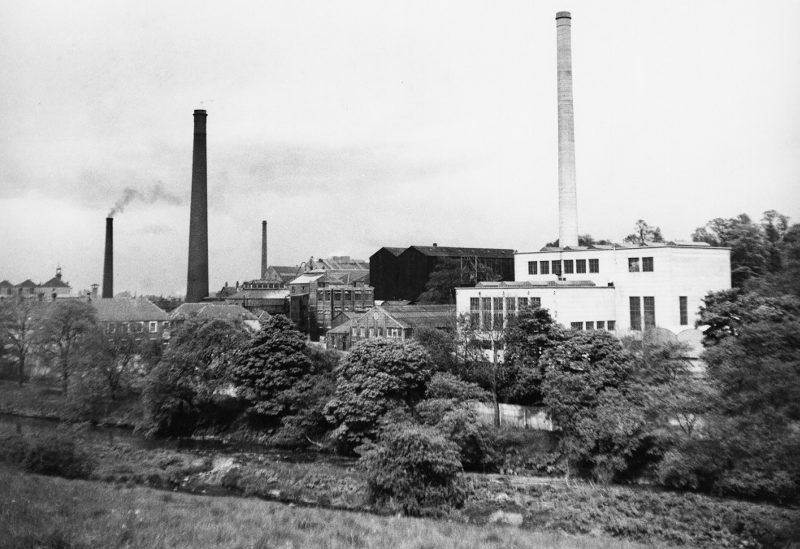
Inveresk paper mill. The mill lade is in the foreground and beyond are the power plant and turbine house on the right, the engineers’ and electricians’ workshop in the centre and the old ‘Salle’ (finishing department) on the left.
In earlier times, paper making was one of the major industries of Musselburgh, and the Inveresk Paper Company Ltd. (formed 1922) was the parent company of some 16 mills and associated companies in Scotland and England. The industry used the raw materials of imported woodpulp and esparto grass, which were mixed with chemicals. By February 1949, the mill had been extensively reconstructed and modernised, but this did not prevent the 600 workers (200 of whom were women) being put on short time the following August/September. There were still restrictions on the consumption of paper, and trade was slow. In 1952, some 400 of the mill’s employees were on short time working, and by 1959 there were increasing concerns about the future of the paper industry. In 1965, 500 workers at the paper mill went on strike (an indication that it was then still a major employer in the burgh); by February 1971 failure to find a buyer ended in closure on the 28th, with around 260 workers made redundant. At this juncture unemployment levels in the town were described as ‘desperate’.
The Net Mill
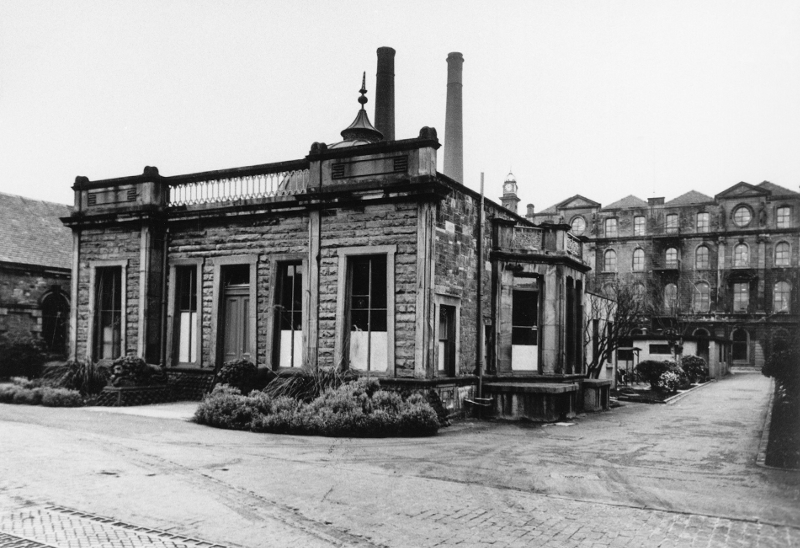
Main offices of Stuart’s Net Mills, built early 1900s. Spinning mill can be seen in background.
From its beginning in 1812 the net mill of J. & W. Stuart Ltd was a major employer in the burgh; the following summary encapsulates its decline in our period.
| Net mill | |
|---|---|
| 1812 | Colonel J. Paterson patented his Scottish net loom. |
| 1820 | He set up a net manufacturing firm (using hemp) in Bridge Street, Musselburgh. |
| 1830s | Had 18 looms. |
| 1849 | Firm (and patent) sold to James and William Stuart. |
| 1854 | J. & W. Stuart built a new factory at Esk Mills – to accommodate 100 looms and other machinery. |
| 1865 | Cotton being used instead of hemp. |
| by 1869 | New cotton mill – four acres, employing c. 800 spinners and weavers, many of whom were women and girls – cheaper than men. |
| 1920 | Company joined with J. Jack & Sons – factories at Stonehaven, Buckie, and Lowestoft. |
| 1924 | Branch established in Sydney, Australia. |
| 1925 | Subsidiary company formed in Lisbon – providing sardine nets to Portugal and its African colonies. |
| In war time, Stuart’s manufactured anti-submarine net defences | |
| 1953 | Subsidiary company in New Brunswick, Canada |
| 1950s | Stuart’s were making two ranges of products; netting yarns and woven products like carpet backings. As the government gave grants for the renewal of machinery, and textiles were subsidised, the looms for the woven products were all renewed. The net making equipment was not. |
| 1950s | Synthetic fibres were being introduced and cheaper imports of woven goods were coming into the UK from the Far East. |
| 1956 | Around 500 employees, mostly female. |
| 1960s | Stuart’s were using synthetics for their nets. Synthetic netting imports were also coming in from Portugal and Spain. |
| 1973 | Three-day week: old factory proved to be falling around the firm’s ears; moved to smaller works building, previously the firm’s offices. |
| 1970s | Stuart’s had a factory in Angola and another in Oporto, Portugal, both producing materials. |
| 1974 | Portugal nationalised everything, so Stuart’s lost the business; about the same time, the Angolan war caused further problems. As a result, Stuart’s stopped producing its own materials and began to buy them in. |
| 1975 | Stonehaven factory closed. |
| 1975 | Net mill workers at Stuart’s on short time for past year – slump in demand for textiles. 50 women working a two-day week. |
| 1976 | Lowestoft closed. |
| 1978 | Gundry, a company from Bridport, Dorset, bought shares in J. & W. Stuart Ltd., so firm of J. & W. Stuart now part of Bridport Gundry Group. Gundry had modern machinery, and few customers, while Stuart’s had the custom and old machinery. The net weaving side of the business was relocated to Gundry’s Dorset base, thus reducing the number of competitors but taking the net making industry away from Scotland. |
| 1978/79 | Firm now Stuart & Gundry. |
| 1980 | Fraserburgh and Buckie factories closed. |
| 1982 | Walter Hay appointed managing director. |
| 1983 | John Stuart sold his interest in the company. |
| 1983 | Firm now owned by Bridport Gundry Co.; known as Stuart/ Bridport Gundry Co. July – moved to new modern factory extending over three new units at Inveresk Industrial Estate – a Scottish Development Agency site, later purchased by Stuart’s; the factory was located on what had been the old drying-green area of J. & W. Stuart Ltd., where the natural-fibred nets were dried. |
| 1985 | Stuart’s won an award from the Scottish Development Agency. |
| 1993 | Firm bought over by a management buy-out; now known as J. & W. Stuart Ltd. Managing directors, Walter Hay and Ivan Stevenson. |
| 1993 | 19 employees. |
| 1998 | Firm moved from Inveresk to Eyemouth; the government designated certain ports to land fish; it seemed prudent to move the business operation to where the client base was, otherwise it was possible that another firm might move to Eyemouth and take the business away from the firm. There was by this time little or no fishing out of Musselburgh. |
| 2000 | The firm has an average of 20 employees. |
From 1978 (although through EC policies and recession there was a slump in the 1990s) the rise of fish farming meant a successful diversification into manufacturing nets for aquaculture and Stuart’s markets and exports its products all over the world. Computers are used for the design process. Amongst other things, Stuart’s makes cages, predator nets and sweep nets, a range of chandlery goods, and nets for a whole range of other uses. It also services and repairs its products.
Thanks to Walter Hay, managing director for his assistance in clarifying this summary.
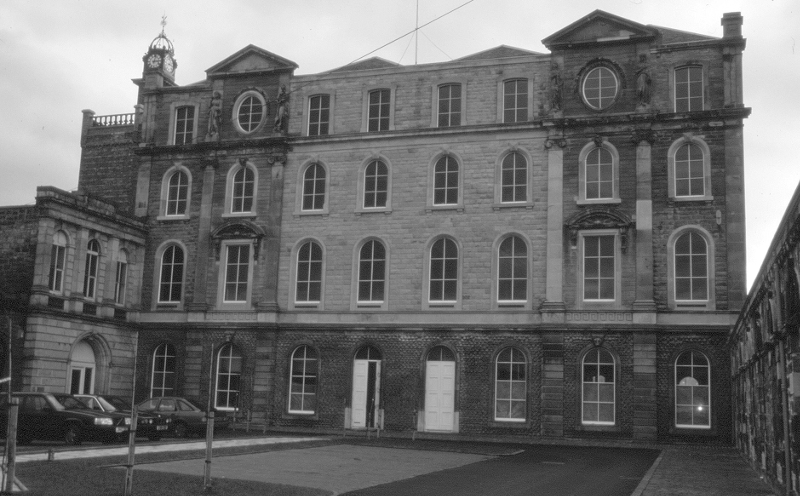
Eskmills after renovation, pictured Feb, 1992
After the firm’s re-location, the old Eskmills building, once one of the finest examples of industrial architecture in the country, lay empty for some time but was eventually purchased by Isertal developers and sensitively restored to become the centre of Eskmills Park office development. The old Hayweights clock was placed on top of the tower in November 1990 and the development opened in 1991. The clock was once a feature of the 19th century weighbridge, which was removed in the late 1960s to make way for the building of the Brunton Hall.
Mining employment
In the post-war period, miners living in Musselburgh had to commute to work, as the pits that lay close to the burgh at Pinkie, Cowpits, Stoneyhill and Brunstane had long since closed. The nearest collieries were Newcraighall and Prestongrange, but no doubt some men would travel a bit further to Smeaton (Dalkeith Colliery), Carberry, Prestonlinks and Woolmet. Of these, only the Dalkeith mines continued beyond the 1960s, closing in 1978. By the 1960s, however, there was alternative employment available at the new Monktonhall Colliery (see The Coal Industry – an Overview by George Archibald, and From March to March: the Miners’ Strike 1984-1985 by Rab Amos).
Musselburgh did come close to having its own colliery in the 1970s when the NCB proposed to sink a shaft near the foreshore to work the undersea reserves of coal. The old gasworks site at Balcarres Road was chosen and purchased. A large housing block opposite the site was also purchased and its tenants rehoused. However, proposed planning requirements became the subject of so much protracted negotiations that, by the time matters were resolved, the need for coal had changed and the project was abandoned.
Fishing
The mussel beds
There has been no commercial fish farming undertaken in the parish but up until the mid- 1960s mussels were gathered from the prolific beds on Fisherrow foreshore. This long established practice was stopped when a ban on the collection of shellfish was placed on the public due to a higher recognition of the dangers of pollution; this had always existed in the estuary due to the discharge of untreated sewage. Latterly mussels were gathered by the last of a band of hardy women, who brought them ashore, boiled and pickled them in their kitchen for sale on the streets and in public houses in Edinburgh. In former years mussels had been gathered by the wives of the local fishermen to bait the hooks of the ‘small lines’ used by their menfolk to fish for haddock and other whitefish. In the late 1990s a major project was undertaken along the Forth to pipe all sewage to processing plants situated at sites on the coast. This has resulted in the water quality of the estuary being so improved that proposals have been made to reseed the mussel beds with a view to ‘farming’ them once again.
Sea fishing
Fisherrow has long been the home port for a thriving fishing fleet. During the second world war those vessels, which were not commandeered for war service, continued to fish for herring and sprats, sailing to ports as far apart as Stornoway in the north, the Isle of Man and the Clyde in the west to Whitby and Seahouses in the south.
In 1945 there were some 36 boats of 45-50ft in size, six of which had returned to their owners after the war (two did not). The traditional method of fishing for herring was changing and whilst the boats continued to use drift nets – a method of fishing using a fleet of some 70/80 single nets strung out in a long line like a curtain from one boat – a newer more efficient method, the ring net, was being introduced. This required two boats working in pairs with each neighbour boat carrying one large net, which was capable of being used several times per night and could catch large quantities of herring. The ring net fishing soon took over as the principal method of fishing for herring but the small boats became underpowered and were too small for the purpose so in 1947/48 a newer class and size of vessel was introduced to the fleet. These vessels, which were 55ft long and designed for ring net fishing, had larger fishhold capacity and more powerful engines capable of towing and driving at faster speeds. Also, the boats were adaptable and in the spring months (when there was no herring being fished), instead of laying up, the boats began to transfer to fishing for white fish and prawns. The smaller boats, which were now much older, many having been built in 1935, became less capable of pursuing other methods of fishing and were sold off by their owners, many of whom themselves were at retiral age.
The fleet had reduced to ten pairs of boats by 1960; as fishing for herring and white fish became more difficult and more men were leaving the job with no young men taking up fishing, more boats were sold off. By the 1970s the fleet was down to eight boats. Herring was no longer fished and the boats that remained were further converted by having their layout changed and more powerful engines fitted; they fished exclusively for white fish and latterly for prawns. In 1970 a larger class of boats of 70ft length, which were capable of going further out to sea for longer periods of time, were commissioned. However, due to their size and draught, the harbour at Fisherrow (which was still the port of registration) became unsuitable, so these big boats used other harbours – Eyemouth and North Shields – where there was access and a market for their fish.
Changes to fishing methods again saw these ‘big’ boats transferring from working alone to working in pairs using sophisticated instrumentation and enormous sized trawl nets to fish in distant, deep waters for white fish. In the late 1980s and through the 1990s political and conservation constraints were put upon the fleet of vessels (which had reduced to only six in number) such that they too have been sold off or decommissioned. At the start of the new century there were only two boats in the ‘home’ fleet.
The harbour
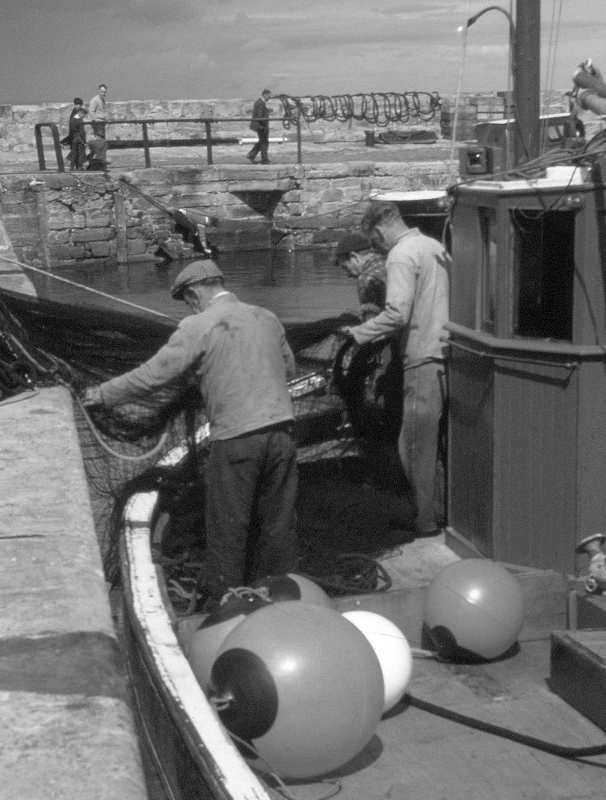
Fishing boat in Fisherrow harbour
When the harbour at Fisherrow was the home port to an active herring fishing fleet, it was used extensively from the months of October/November to March/April when the boats would come and go when fishing for herring and sprats in the Forth. During that time the harbour was a ‘hive of activity’, which changed in the summer months when the boats would fish away from home. However, as fishing methods changed and the number of vessels reduced in numbers, with the larger boats using others ports, the harbour became redundant.
There had always been a few yachts and small motorboats based in the harbour, which, with the establishment of Fisherrow Yacht Club in 1957, saw their numbers increase and now the harbour is in the main a marina for such vessels. The harbour itself has changed little since 1945. The swimming hut situated at the end of the West Pier was removed as were the railway lines which ran up its length; the gas lamps were replaced by electric lights, which have been modernised, and after a fierce storm in 1949 extensive repairs were done to the damage on the West Pier and some remedial work has been done to the East Pier. Due to its location, the tidal harbour has been prone to silting. Despite having been dredged some years back, silt is building up again.
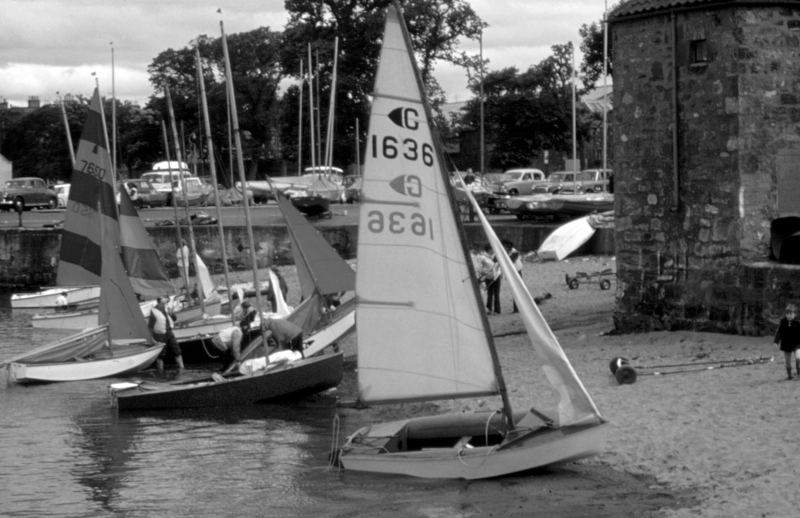
Yachts at Fisherrow harbour
The Custom House situated on the harbour apron has been used for a variety of purposes over the years and until the mid 1990s it was the base for HM Coastguard.
At the start of the 21st century the harbour, although changing considerably in its use, has remained much the same in layout as it did in 1945.
Market gardening
Up to its closure in 1976 the firm of David Lowe & Son was the largest grower of vegetables in Scotland and ran one of the biggest horticultural operations in Musselburgh. Land was used from the surrounding parishes (in the 1960s some 2000 acres) but Lowe’s was essentially a Musselburgh firm, employing 300 regular workers and hundreds of casuals – many of them women and children (13+) (Official Guide to Musselburgh, 1961 p30). When efforts to save the firm failed, its closure in 1976 saw the end of a 116-year history, and 175 workers were unemployed.
Here, Jim Brown shares his experiences of being a horticultural worker for Lowe’s:
Having lived at Gladsmuir and with little work available, farmwork was the only choice when I left school. Sir David Lowe had taken over Trabroun Farm where soft fruit like blackcurrants and rasps were grown. Fruit trees were grown round the big house previously owned by Lord Ainslie.
After returning from the Forces in 1945 and being married, I got a house in Inveresk Road, Musselburgh, above Haddon’s shop and opposite Brunton’s Wire Mill gates, but there was the strong smell from the acid tanks and unhealthy conditions. We were later rehoused in Park Lane. Employment was easier in Musselburgh; I was employed by Lowe’s again as a foreman for vegetable production in the packhouse. The wages were low but overtime was always available and I had three weeks’ paid holidays each year.
During the war a number of POWs, mainly Germans and Ukrainians, were employed by Lowe’s. They were given accommodation at Stoneyhill Farm and those who were tradesmen (bricklayers, electricians, etc) were given full-time work. Transport to work was provided by ex-service buses. One bus brought female workers from Seton East and Seton West, the other those from Monktonhall. The buses also gave the women somewhere to shelter in bad weather. I can’t remember any protective clothing being supplied other than to the packhouse staff where water was constantly used for the washing of vegetables going to market.
Scarlett’s of Sweethope were almost as influential in market gardening but their base lay in rural Inveresk, not in the burgh
Golf
Golf has always played a big part in Musselburgh life and after the war ended in 1945 it gradually got going again. Besides providing employment for golf club staff, the sport, a leisure activity for many, undoubtedly brings business through visitors to the town.
The town has three courses, two of 18 and one of nine holes, each of varying character.
The oldest by far is the nine-hole Old Links, situated at the racecourse. In the post-war years it was well used by local golfers, although not having a proper clubhouse. Two greenkeepers looked after it and it was maintained in tidy condition. However, by the late 1950s and into the next two decades the course deteriorated due to a variety of reasons. In 1982 interest was revived with the formation of the Old Course Golf Club, which started off with about 25 members and has grown to 240, comprising 176 men, 31 ladies and 33 juniors. The club has an excellent clubhouse in Balcarres Road and the course is looked after well by two and sometimes three greenkeepers. Unfortunately, the original layout had to be altered when a new National Hunt racing track was laid out alongside the flat circuit in the 1980s. An advantage in this, however, is that the 3rd and 4th holes are angled away from the busy Linkfield Road.
The Royal Musselburgh Golf Course is two miles outwith the parish on the road to North Berwick, on parkland surrounding Prestongrange House (see Prestonpans parish).
The third of the town’s courses, the Musselburgh Golf Course, is sited at Monktonhall. Opened in 1938 to a James Braid design, it is a challenging course of championship standard. During the war a substantial part of the course was taken over for agriculture and it was only in the late 1940s that the course was restored to its full layout. Membership in 1949 was 450 men, 34 ladies and 34 juniors. By 2000 there were 783 men, 86 ladies and 87 juniors (80 boys, seven girls). During the 1950s extensive tree planting was carried out and this dramatically enhanced the course. In the late 1940s, 1950s and 1960s there were three or four greenkeeping staff. This rose to five in the 1970s and 1980s and at the present moment there are six.